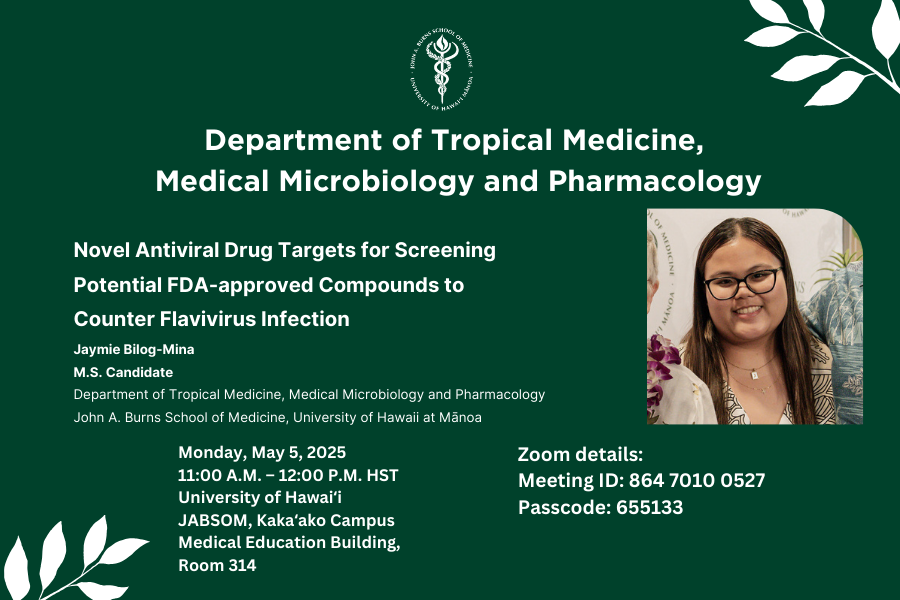
Thesis Defense: ”Novel Antiviral Drug Targets for Screening Potential FDA-approved Compounds to Counter Flavivirus Infection”
In Person & By Zoom
Zoom Link: https://us02web.zoom.us/j/86470100527?pwd=yNErmgC9W8vLGFGhrrokqBC097ihr5.1
Meeting ID: 864 7010 0527
Passcode: 655133
Jaymie Bilog-Mina
M.S. Candidate
Department of Tropical Medicine, Medical Microbiology and Pharmacology
John A. Burns School of Medicine, University of Hawaiʻi at Mānoa
Dengue (DENV) and West Nile viruses (WNV) are major global health concerns, with WNV prevalent in the U.S. and DENV occasionally detected in Hawaii. Currently, no effective antiviral treatments exist for flavivirus infections, highlighting the need for new drug targets. NS3, a key enzyme in viral replication, must localize to the replication organelle (RO), composed of convoluted membranes (CMs) and vesicle packets (VPs). This study explores the role of NS4A and NS4B in facilitating NS3’s movement within the RO using high-resolution confocal microscopy (HRCM). HEK293 cells were co-transfected with NS3 and different forms of NS4A/NS4B (NS4AB, NS4A, NS4B) and triple-transfected with Sec61β-RFP, an ER marker, under WNV-infected and uninfected conditions. Additionally, the contribution of NS1 was assessed by transfecting HEK-293 cells with Sec61β-RFP, NS1 in its non-permeabilized and permeabilized forms, and either NS3 or different forms of NS4A/NS4B. Confocal imaging and Pearson Correlation Coefficient (PCC) analysis demonstrated that NS3 localizes to the foci (RO) when viral structures appear as fluorescent aggregates, indicating a random recruitment event during RO formation. In infected cells, NS3 was additionally recruited to the rough endoplasmic reticulum (RER) before reaching the RO, suggesting that other viral proteins play a role in its translocation. In the presence of NS1, some of the NS3 is visualized in the ER and the foci in both non-permeabilized and permeabilized conditions, indicating NS1 plays a role in stabilizing NS3 in the RO. These findings suggest two possible mechanisms for NS3 recruitment: (1) random encapsulation during RO formation and (2) a sequential process requiring additional viral factors, involving NS2B and possibly NS1. Understanding these interactions may help identify new antiviral drug targets for the further development of safe and effective antiviral therapies.
More Information
See additional info here.